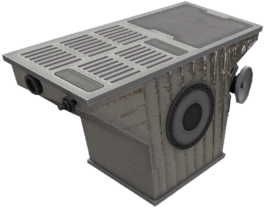MPO Probe
| MPO Probe | |||||
| Command module by STEADLER Engineering Corps | |||||
| Radial size | Large | ||||
| Cost | (total) | 9 900.00 | |||
| (dry) | 9 854.10 | ||||
| Mass | (total) | 0.895 t | |||
| (dry) | 0.395 t | ||||
| Drag | 0.15-0.2 | ||||
| Max. Temp. | 2200 K | ||||
| Impact Tolerance | 9 m/s | ||||
| Research | | ||||
| Unlock cost | 34 700 | ||||
| Since version | 1.10 | ||||
| Part configuration | MpoProbe.cfg | ||||
| Electricity required | 3.00 ⚡/min | ||||
| Torque | 6 kN·m | ||||
| Electricity required |
| ||||
| SAS level | 3 | ||||
| Field of View | (min) | 3 ° | |||
| (max) | 84 ° | ||||
| Anomaly detection | 35 % | ||||
| Enhanceable | No | ||||
| Modes | Biome | ||||
| Terrain | |||||
| Antenna type | Relay | ||||
| Antenna rating | 2 Gm | ||||
| Packet size | 1 Mits | ||||
| Transmission speed | 2.86 Mits/s | ||||
| Electricity required | 24 ⚡/Mits | ||||
| Packed volume | None | ||||
| Liquid fuel | 45 | ||||
| Oxidizer | 55 | ||||
| Electric capacity | 1000 ⚡ | ||||
The MPO Probe, formally the Moho Planetary Observer, is an unmanned command module with a built-in rocket fuel tank.
Contents
Usage
Like the Probodobodyne HECS2, the MPO incorporates many parts into one. It has the electric capacity of a Z-4K Rechargeable Battery Bank, more than the torque of a Small Inline Reaction Wheel, the antenna rating of an RA-2 Relay Antenna, and the rocket fuel capacity of a FL-T100 Fuel Tank. Notably, it is the only command module with a built-in relay antenna; this also allows it to transmit Science without any extra parts.
The MPO's unusual shape makes it ill-fitted for atmospheric use, and a fairing should be used to launch it into orbit. However, it is very capable once in space. With just a 48-7S "Spark" Liquid Fuel Engine attached, the MPO has a delta-V of 2100 m/s.
As of 1.12, the MPO's KerbNet module has the third greatest anomaly detection rate. Compared to the top two command modules, it has a far greater FoV. This makes the MPO an excellent choice for scanning for anomalies.
The MPO has a higher heat tolerance than most other unmanned command modules.
Product description
| “ | The Moho Planetary Observer combines the functions of many parts in one, to help make sure the searing heat of its primary mission target is distributed and dissipated without harming its critical control functionality. — STEADLER Engineering Corps |
” |
Trivia
- Along with the MTM Stage, the MPO Probe is derived from the BepiColombo mission as part of the 1.10 Shared Horizons update. Specifically, the MPO Probe is modeled after the ESA's Mercury Planetary Observer.
Changes
- Initial release
